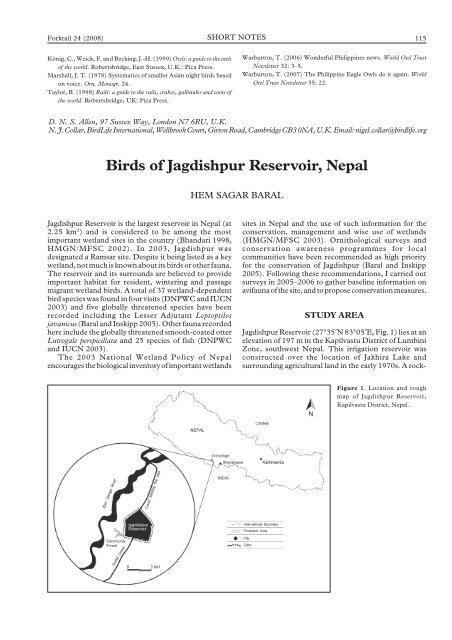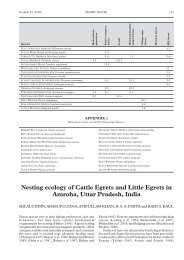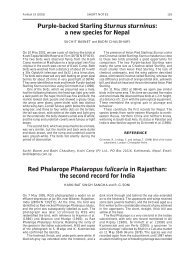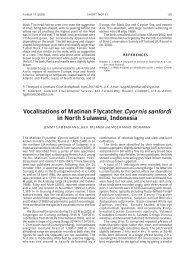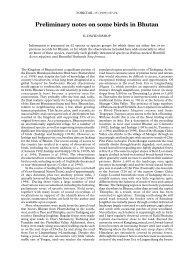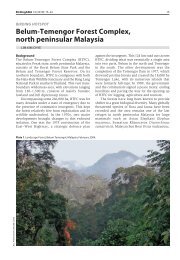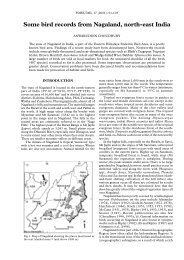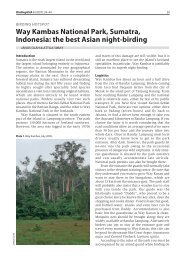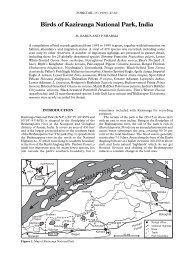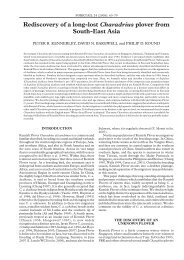Birds of Jagdishpur Reservoir, Nepal Forktail 24 ... - Oriental Bird Club
Birds of Jagdishpur Reservoir, Nepal Forktail 24 ... - Oriental Bird Club
Birds of Jagdishpur Reservoir, Nepal Forktail 24 ... - Oriental Bird Club
Create successful ePaper yourself
Turn your PDF publications into a flip-book with our unique Google optimized e-Paper software.
<strong>Forktail</strong> <strong>24</strong> (2008) SHORT NOTES 115<br />
König, C., Weick, F. and Becking, J.-H. (1999) Owls: a guide to the owls<br />
<strong>of</strong> the world. Robertsbridge, East Sussex, U.K.: Pica Press.<br />
Marshall, J. T. (1978) Systematics <strong>of</strong> smaller Asian night birds based<br />
on voice. Orn. Monogr. <strong>24</strong>.<br />
Taylor, B. (1998) Rails: a guide to the rails, crakes, gallinules and coots <strong>of</strong><br />
the world. Robertsbridge, UK: Pica Press.<br />
<strong><strong>Bird</strong>s</strong> <strong>of</strong> <strong>Jagdishpur</strong> <strong>Reservoir</strong>, <strong>Nepal</strong><br />
<strong>Jagdishpur</strong> <strong>Reservoir</strong> is the largest reservoir in <strong>Nepal</strong> (at<br />
2.25 km 2 ) and is considered to be among the most<br />
important wetland sites in the country (Bhandari 1998,<br />
HMGN/MFSC 2002). In 2003, <strong>Jagdishpur</strong> was<br />
designated a Ramsar site. Despite it being listed as a key<br />
wetland, not much is known about its birds or other fauna.<br />
The reservoir and its surrounds are believed to provide<br />
important habitat for resident, wintering and passage<br />
migrant wetland birds. A total <strong>of</strong> 37 wetland-dependent<br />
bird species was found in four visits (DNPWC and IUCN<br />
2003) and five globally threatened species have been<br />
recorded including the Lesser Adjutant Leptoptilos<br />
javanicus (Baral and Inskipp 2005). Other fauna recorded<br />
here include the globally threatened smooth-coated otter<br />
Lutrogale perspicillata and 25 species <strong>of</strong> fish (DNPWC<br />
and IUCN 2003).<br />
The 2003 National Wetland Policy <strong>of</strong> <strong>Nepal</strong><br />
encourages the biological inventory <strong>of</strong> important wetlands<br />
HEM SAGAR BARAL<br />
Warburton, T. (2006) Wonderful Philippines news. World Owl Trust<br />
Newsletter 32: 3–5.<br />
Warburton, T. (2007) The Philippine Eagle Owls do it again. World<br />
Owl Trust Newsletter 35: 22.<br />
D. N. S. Allen, 97 Sussex Way, London N7 6RU, U.K.<br />
N. J. Collar, <strong>Bird</strong>Life International, Wellbrook Court, Girton Road, Cambridge CB3 0NA, U.K. Email: nigel.collar@birdlife.org<br />
sites in <strong>Nepal</strong> and the use <strong>of</strong> such information for the<br />
conservation, management and wise use <strong>of</strong> wetlands<br />
(HMGN/MFSC 2003). Ornithological surveys and<br />
conservation awareness programmes for local<br />
communities have been recommended as high priority<br />
for the conservation <strong>of</strong> <strong>Jagdishpur</strong> (Baral and Inskipp<br />
2005). Following these recommendations, I carried out<br />
surveys in 2005–2006 to gather baseline information on<br />
avifauna <strong>of</strong> the site, and to propose conservation measures.<br />
STUDY AREA<br />
<strong>Jagdishpur</strong> <strong>Reservoir</strong> (27°35′N 83°05′E, Fig. 1) lies at an<br />
elevation <strong>of</strong> 197 m in the Kapilvastu District <strong>of</strong> Lumbini<br />
Zone, southwest <strong>Nepal</strong>. This irrigation reservoir was<br />
constructed over the location <strong>of</strong> Jakhira Lake and<br />
surrounding agricultural land in the early 1970s. A rock-<br />
Figure 1. Location and rough<br />
map <strong>of</strong> <strong>Jagdishpur</strong> <strong>Reservoir</strong>,<br />
Kapilvastu District, <strong>Nepal</strong>.
116 SHORT NOTES <strong>Forktail</strong> <strong>24</strong> (2008)<br />
filled dyke surrounding the reservoir was constructed in<br />
the early 1980s. The reservoir is fed through a canal from<br />
the nearby Ban Ganga River that has a catchment area in<br />
the Churia Hills. Maximum water depth varies between<br />
7 m in the monsoon and 2 m in drier months. The reservoir<br />
is surrounded by cultivated land, which also holds large<br />
numbers <strong>of</strong> birds (L. Gurung verbally 2006).<br />
The reservoir bank is planted mostly with Dalbergia<br />
sissoo and some Acacia catechu. Floating vegetation is<br />
dominated by Nelumbo nucifera, followed by Hygrorhiza<br />
aristata and Potamogetan nodosus. Submerged plants<br />
include Naja minor, Ceratophyllum demersum and Hydrilla<br />
verticillata. The reservoir margin holds Ipomoea carnea<br />
and Typha sp. Most aquatic vegetation is submerged,<br />
with patches <strong>of</strong> the lake covered by floating species or<br />
occupied by reed swamps.<br />
METHODS<br />
Surveys at <strong>Jagdishpur</strong> reservoir were conducted on 11<br />
May 2005, 11 October 2005, 6 January 2006 and 23<br />
March 2006. These visits were spread through the year in<br />
order to assess seasonal status. All surveys were carried<br />
out on foot. Each survey was conducted by two people,<br />
one to identify and count the species and the other to<br />
write down the data. The surveyors followed a fixed route,<br />
starting from the main outlet sluice, then slowly walking<br />
around the reservoir in a clockwise direction, and ending<br />
at the start point. Surveys were carried out between 08h00<br />
to 12h00, each walk typically lasting 3–4 hr. <strong><strong>Bird</strong>s</strong> were<br />
identified using 10× binoculars and 20× spotting scopes.<br />
Total counts were made <strong>of</strong> all birds in the reservoir, or<br />
outside it but within 500 m <strong>of</strong> the dam. For species flying<br />
in flocks, repeat counts were made and the highest count<br />
taken. Informal interviews with members <strong>of</strong> the local<br />
community were used to gather information on<br />
conservation issues.<br />
In this account, I follow Bhandari (1998) when<br />
classifying species as wetland-dependent. For seasonal<br />
status <strong>of</strong> species, I mostly follow Inskipp and Inskipp<br />
(1991).<br />
RESULTS AND DISCUSSION<br />
A total <strong>of</strong> 108 bird species was recorded from the<br />
<strong>Jagdishpur</strong> <strong>Reservoir</strong> area (Appendix), nearly half being<br />
either winter visitors or passage migrants. Ten species<br />
were seen on all four visits. Of these, Lesser Whistling<br />
Duck Dendrocygna javanica was the most abundant, with<br />
2,000 individuals counted in March. Other high species<br />
counts included 6,000 Common Coots Fulica atra in<br />
January, which is perhaps the highest count for this species<br />
in the country. Twelve <strong>of</strong> the 25 most abundant species<br />
are winter visitors or passage migrants in <strong>Nepal</strong>.<br />
Winter migrants reached peak abundance in January.<br />
Other species, mostly resident, were most abundant in<br />
March. This may have been due to the lower water levels<br />
and consequently higher food availability in March. In<br />
addition, most smaller wetlands in the vicinity dry up at<br />
this time <strong>of</strong> the year, and this may act to concentrate birds<br />
at perennial waterbodies. Cotton Pygmy Goose Nettapus<br />
coromandelianus, Red-wattled Lapwing Vanellus indicus<br />
and Paddyfield Pipit Anthus rufulus reached peak<br />
abundance in October—these are likely to breed in the<br />
reservoir or its vicinity. A colony <strong>of</strong> Asian Openbill<br />
Anastomus oscitans has recently been found breeding near<br />
Lumbini (Giri 2008). May is usually a significant month<br />
for passage migrants in <strong>Nepal</strong> but this is not reflected in<br />
the numbers from <strong>Jagdishpur</strong>. There are records <strong>of</strong><br />
Whiskered Tern Chlidonias hybridus and Garganey Anas<br />
querquedula on passage in May 2003 (Baral and Chaudhary<br />
2003).<br />
This survey adds 18 wetland-dependent bird species<br />
to the <strong>Jagdishpur</strong> list prepared by DNPWC and IUCN<br />
(2003). Six additional wetland-dependent species, not<br />
found during this survey, have previously been recorded<br />
(J. Cox in litt. to C. Inskipp, Baral and Chaudhary 2003,<br />
Choudhary and Giri 2006). This gives a total <strong>of</strong> 61<br />
wetland-dependent bird species for <strong>Jagdishpur</strong> (see<br />
Appendix for a full list). An additional 57 species were<br />
recorded in the reservoir area. The habitat appears<br />
particularly suitable for ducks and other large waterfowl,<br />
and less suitable for waders.<br />
Several species, listed for the area by DNPWC and<br />
IUCN (2003), were not observed during this survey:<br />
Cinnamon Bittern Ixobrychus cinnamomeus, Yellow Bittern<br />
I. sinensis, Black-bellied Tern Sterna acuticauda and Indian<br />
Spotted Eagle Aquila hastata (recently split from Lesser<br />
Spotted Eagle A. pomarina: Parry et al. 2002). In total,<br />
seven globally threatened species and three Near-<br />
Threatened species have been recorded from the reservoir<br />
(Appendix). Incorporating all available and reliable bird<br />
information, the overall bird list for <strong>Jagdishpur</strong> comes to<br />
118 species, including seven globally threatened species.<br />
CONSERVATION ISSUES<br />
During this survey, various disturbances, including bird<br />
hunting, were observed. Other threats to the site include<br />
unsustainable methods <strong>of</strong> harvesting fish and other natural<br />
resources, siltation, deposition <strong>of</strong> detritus from aquatic<br />
macrophytes, water pollution from agricultural chemicals,<br />
and invasive alien species such as Eichhornia crassipes<br />
(DNPWC and IUCN 2003). The dense aquatic<br />
macrophyte vegetation indicates an advanced eutrophic<br />
status and a high sedimentation rate.<br />
Every year the reservoir is partially drained to collect<br />
fish and other resources like snails and edible plants.<br />
During this operation, the inflow <strong>of</strong> water to the reservoir<br />
is lessened or stopped and outflow increased. Fishermen<br />
working in the reservoir pump water out, <strong>of</strong>ten using<br />
mechanised pumps. When the water level is less than<br />
knee-deep, fish are caught with nets and by hand. Different<br />
parts <strong>of</strong> the reservoir are drained at different times, and<br />
in exceptionally dry years, the entire reservoir has<br />
occasionally been completely drained to catch fish. The<br />
reservoir also contributes apple snails Pila globosa and<br />
water-chestnut Trapa bispinosa for food, cattails Typha<br />
elephantina for mat-making, and Ipomoea carnea for<br />
fuelwood (D. Giri verbally 2006, L. Gurung verbally 2006,<br />
HSB pers. obs.). Management <strong>of</strong> the reservoir to promote<br />
biodiversity needs study. For example, partial draining<br />
may have less <strong>of</strong> an effect than complete draining <strong>of</strong> the<br />
reservoir. Draining will need to be carried out at those<br />
times which minimise impacts on birdlife.<br />
Although the site has been proposed as a bird sanctuary,<br />
nothing has been done so far to achieve this. Local people
<strong>Forktail</strong> <strong>24</strong> (2008) SHORT NOTES 117<br />
are reportedly interested promoting the area as a birding<br />
and recreational destination (L. Gurung verbally 2006),<br />
and this opens up possibilities <strong>of</strong> tourism-based<br />
conservation. Such programmes at <strong>Jagdishpur</strong> could be<br />
linked with the village tourism programme conducted in<br />
other areas <strong>of</strong> Kapilvastu district. However, care must be<br />
taken to minimise disturbance to wildlife. For example,<br />
current plans include promoting boating on the lake, which<br />
is likely to increase disturbance levels.<br />
Active enhancement <strong>of</strong> habitat quality may also be<br />
needed, for example creating shallow mudflats and<br />
Phragmites marshes, creating nesting islands, and installing<br />
nextboxes. While carrying out these and other<br />
conservation activities, care must be taken to avoid<br />
potential conflict with local people, and various<br />
stakeholders should be consulted, including the Village<br />
Development Committee, the District Irrigation Office<br />
and the Department <strong>of</strong> National Parks and Wildlife<br />
Conservation.<br />
ACKNOWLEDGEMENTS<br />
I would like to thank the <strong>Oriental</strong> <strong>Bird</strong> <strong>Club</strong> (OBC) and the Ramsar<br />
Convention Secretariat (RCS), for funding this survey. I thank David<br />
Buckingham (OBC), and Pragati Tuladhar and Sandra Hails (RCS)<br />
for their support and guidance. Dinesh Giri, Tika Giri, Dhan Bahadur<br />
Chaudhary, Mark Mallalieu, Bhesh Raj Ghimire and Yub Raj Basnet<br />
assisted in the field. Sharad Singh <strong>of</strong> Lumbini Buddha Garden Lodge<br />
helped with logistics. I am grateful to Carol Inskipp for her support to<br />
carry out this survey.<br />
REFERENCES<br />
Baral, H. S. and Chaudhary, B. (2003) A list <strong>of</strong> birds recorded at <strong>Jagdishpur</strong><br />
<strong>Reservoir</strong>, May 2003. Unpublished report submitted to <strong>Bird</strong><br />
Conservation <strong>Nepal</strong><br />
Baral, H. S. and Inskipp, C. (2005) Important <strong>Bird</strong> Areas in <strong>Nepal</strong>: key<br />
sites for conservation. Kathmandu and Cambridge, U.K.: <strong>Bird</strong><br />
Conservation <strong>Nepal</strong> and <strong>Bird</strong>Life International.<br />
Bhandari, B., ed. (1998) An inventory <strong>of</strong> <strong>Nepal</strong>’s terai wetlands. Kathmandu:<br />
IUCN-<strong>Nepal</strong>.<br />
<strong>Bird</strong>Life International (2008) Species Factsheets. Available at http://<br />
www.birdlife.org. Accessed on 8 June 2008.<br />
Choudhary, H. and Giri, D. (2006) A list <strong>of</strong> birds recorded in Lumbini,<br />
<strong>Jagdishpur</strong> <strong>Reservoir</strong> and Khadara Phanta, November 2006.<br />
Unpublished.<br />
DNPWC and IUCN (2003) Information sheet on Ramsar wetlands:<br />
<strong>Jagdishpur</strong> <strong>Reservoir</strong>. Unpublished report submitted to the Ramsar<br />
Convention Bureau.<br />
Giri, D. (2008) Largest breeding colony <strong>of</strong> Asian Openbill Anastomus<br />
oscitans outside protected areas <strong>of</strong> <strong>Nepal</strong>. Danphe 17(1): 7.<br />
HMGN/MFSC (2002) <strong>Nepal</strong> biodiversity strategy. Kathmandu: Ministry<br />
<strong>of</strong> Forest and Soil Conservation, His Majesty’s Government <strong>of</strong> <strong>Nepal</strong>.<br />
HMGN/MFSC (2003) National wetland policy 2003. Kathmandu:<br />
Ministry <strong>of</strong> Forest and Soil Conservation, His Majesty’s Government<br />
<strong>of</strong> <strong>Nepal</strong>.<br />
Inskipp, C. and Inskipp, T. (1991) A guide to the birds <strong>of</strong> <strong>Nepal</strong>, Second<br />
edition. London: Christopher Helm.<br />
Inskipp, T., Lindsey, N. and Duckworth, W. (1996) An annotated checklist<br />
<strong>of</strong> the birds <strong>of</strong> the <strong>Oriental</strong> region. Sandy, U.K.: <strong>Oriental</strong> <strong>Bird</strong> <strong>Club</strong>.<br />
IUCN <strong>Nepal</strong> (2004). A review <strong>of</strong> the status and threats to wetlands in <strong>Nepal</strong>.<br />
Kathmandu: IUCN <strong>Nepal</strong>.<br />
Parry, S. J., Clark, W. S. and Prakash, V. (2002). On the taxonomic<br />
status <strong>of</strong> the Indian Spotted Eagle Aquila hastata. Ibis 144: 665–675.<br />
Hem Sagar Baral, PO Box 1<strong>24</strong>65, <strong>Bird</strong> Conservation <strong>Nepal</strong>, Kathmandu, <strong>Nepal</strong>. Email: hem@birdlifenepal.org<br />
APPENDIX<br />
A complete checklist, with counts, <strong>of</strong> birds recorded in <strong>Jagdishpur</strong> <strong>Reservoir</strong>. Counts are given for those species<br />
recorded in four surveys in 2005 and 2006. For other species, the original source is given. Systematic order follows<br />
Inskipp et al. (1996).<br />
Count<br />
Species Status 1 May October January March Source 2<br />
LESSER WHISTLING DUCK Dendrocygna javanica R 70 12 600 2,000<br />
COTTON PYGMY GOOSE Nettapus coromandelianus R 20 31 6 16<br />
GADWALL Anas strepera W 25 327 188<br />
FALCATED DUCK Anas falcata NT 3 W (a)<br />
EURASIAN WIGEON Anas penelope W 150 15<br />
MALLARD Anas platyrhynchos W 11 56<br />
NORTHERN SHOVELER Anas clypeata W 12 28 53<br />
NORTHERN PINTAIL Anas acuta W 5 76<br />
GARGANEY Anas querquedula W 19<br />
COMMON TEAL Anas crecca W 176 610<br />
RED-CRESTED POCHARD Rhodonessa rufina W 112 18<br />
COMMON POCHARD Aythya ferina W 84 4<br />
FERRUGINOUS DUCK Aythya nyroca NT W 9 52 11<br />
TUFTED DUCK Aythya fuligula W 65 10<br />
COMMON HOOPOE Upupa epops W 2 1
118 SHORT NOTES <strong>Forktail</strong> <strong>24</strong> (2008)<br />
Count<br />
Species Status 1 May October January March Source 2<br />
INDIAN ROLLER Coracias benghalensis R 1 2<br />
COMMON KINGFISHER Alcedo atthis R 1 4 2<br />
WHITE-THROATED KINGFISHER Halcyon smyrnensis R 7 9 4<br />
PIED KINGFISHER Ceryle rudis R 1 4<br />
GREEN BEE-EATER Merops orientalis R 4<br />
BLUE-TAILED BEE-EATER Merops philippinus S 2<br />
INDIAN CUCKOO Cuculus micropterus S 1<br />
GREATER COUCAL Centropus sinensis R 2<br />
ROSE-RINGED PARAKEET Psittacula krameri R 8<br />
SPOTTED OWLET Athene brama R 2<br />
SPOTTED DOVE Streptopelia chinensis R 1 1 4<br />
EURASIAN COLLARED DOVE Streptopelia decaocto R 11<br />
SARUS CRANE Grus antigone VU S 8<br />
BROWN CRAKE Amaurornis akool R 1<br />
BAILLON’S CRAKE Porzana pusilla W (b)<br />
WATERCOCK Gallicrex cinerea S 1<br />
PURPLE SWAMPHEN Porphyrio porphyrio R 5 49 18<br />
COMMON MOORHEN Gallinula chloropus W 12 20 21<br />
COMMON COOT Fulica atra W 109 6,000 400<br />
PINTAIL SNIPE Gallinago stenura W (c)<br />
COMMON GREENSHANK Tringa nebularia W 1 2 7<br />
GREEN SANDPIPER Tringa ochropus W 2<br />
PHEASANT-TAILED JACANA Hydrophasianus chirurgus R 8 16<br />
BRONZE-WINGED JACANA Metopidius indicus R 13 8 2 14<br />
LITTLE-RINGED PLOVER Charadrius dubius W 2<br />
GREY-HEADED LAPWING Vanellus cinereus W 6<br />
RED-WATTLED LAPWING Vanellus indicus R 10 37 14 <strong>24</strong><br />
LITTLE PRATINCOLE Glareola lactea S? 15<br />
PALLAS’ GULL Larus ichthyaetus PM (b)<br />
BLACK-BELLIED TERN Sterna acuticauda NT R? (d)<br />
WHISKERED TERN Chlidonias hybridus PM (b)<br />
BLACK-SHOULDERED KITE Elanus caeruleus R 1 4<br />
BLACK KITE Milvus migrans R 2 4<br />
EGYPTIAN VULTURE Neophron percnopterus EN W 2<br />
WHITE-RUMPED VULTURE Gyps bengalensis CR R 21 <strong>24</strong><br />
SLENDER-BILLED VULTURE Gyps tenuirostris CR R 2 7<br />
HIMALAYAN GRIFFON Gyps himalayensis W 6 32<br />
EURASIAN GRIFFON Gyps fulvus W 2<br />
EURASIAN MARSH HARRIER Circus aeruginosus W 1 2 2<br />
SHORT-TOED SNAKE EAGLE Circaetus gallicus W 1<br />
PIED HARRIER Circus melanoleucos W 1 2<br />
SHIKRA Accipter badius R 2<br />
INDIAN SPOTTED EAGLE Aquila hastata VU R (d)<br />
GREATER SPOTTED EAGLE Aquila clanga VU W 1<br />
COMMON KESTREL Falco tinnunculus W 1 2 1<br />
PEREGRINE FALCON Falco peregrinus calidus W 1<br />
LITTLE GREBE Tachybaptus ruficollis R 14 17 46 57<br />
GREAT CRESTED GREBE Podiceps cristatus W 2<br />
DARTER Anhinga melanogaster W 1<br />
LITTLE CORMORANT Phalacrocorax niger R 40 2 2 75<br />
LARGE CORMORANT Phalacrocorax carbo W 1 1<br />
LITTLE EGRET Egretta garzetta R 12 1 8 41<br />
GREY HERON Ardea cinerea W 6 5
<strong>Forktail</strong> <strong>24</strong> (2008) SHORT NOTES 119<br />
Count<br />
Species Status 1 May October January March Source 2<br />
PURPLE HERON Ardea purpurea R 8 2 5<br />
GREAT EGRET Casmerodius albus R 5 1 2 9<br />
INTERMEDIATE EGRET Mesophoyx intermedia R 8 15 29<br />
CATTLE EGRET Bubulcus ibis R 40 21 54<br />
INDIAN POND HERON Ardeola grayii R 16 <strong>24</strong> 5 12<br />
LITTLE HERON Butorides striatus R? 2<br />
YELLOW BITTERN Ixobrychus sinensis S, R? (d)<br />
CINNAMON BITTERN Ixobrychus cinnamomeus S, R? (d)<br />
BLACK IBIS Pseudibis papillosa R 12 23 23<br />
ASIAN OPENBILL Anastomus oscitans R 30 25 73 105<br />
WHITE STORK Ciconia ciconia PM (c)<br />
LESSER ADJUTANT Leptoptilos javanicus VU R 1 3 4 13<br />
BROWN SHRIKE Lanius cristatus W 1<br />
LONG-TAILED SHRIKE Lanius schach R 2 2<br />
RUFOUS TREEPIE Dendrocitta vagabunda R 3 1<br />
HOUSE CROW Corvus splendens R 6 12<br />
LARGE-BILLED CROW Corvus macrorhynchos R 40 5<br />
LARGE CUCKOO SHRIKE Coracina macei R 1<br />
BLACK-HOODED ORIOLE Oriolus xanthornus R 1<br />
BLACK DRONGO Dicrurus macrocercus R 5 40 8<br />
RED-THROATED FLYCATCHER Ficedula parva W 2 10 6<br />
BLUETHROAT Luscinia svecica W 2 4<br />
BLACK REDSTART Phoenicurus ochruros W 2<br />
COMMON STONECHAT Saxicola torquata W 10 2<br />
PIED BUSHCHAT Saxicola caprata R 4 8 7<br />
WHITE-TAILED STONECHAT Saxicola leucura W 2<br />
ASIAN PIED STARLING Sturnus contra R 2 54<br />
COMMON MYNA Acridotheres tristis R 2<br />
PALE MARTIN Riparia diluta W 3<br />
PLAIN MARTIN Riparia paludicola W 50<br />
BARN SWALLOW Hirundo rustica W 2<br />
RED-RUMPED SWALLOW Hirundo daurica W 100<br />
ZITTING CISTICOLA Cisticola juncidis R 2 4<br />
ASHY PRINIA Prinia socialis R 1 2 5<br />
PLAIN PRINIA Prinia inornata R 3 12 7<br />
BLYTH’S REED WARBLER Acrocephalus dumetorum W 1<br />
COMMON CHIFFCHAFF Phylloscopus collybita W 25 3<br />
SMOKY WARBLER Phylloscopus fuligiventer W 3<br />
HUME’S WARBLER Phylloscopus humei W 5<br />
GREENISH WARBLER Phylloscopus trochiloides W 1 3<br />
RUFOUS-WINGED LARK Mirafra assamica R 4 2<br />
ASHY-CROWNED SPARROW LARK Eremopterix grisea R 2<br />
WHITE WAGTAIL Motacilla alba W 1 28<br />
CITRINE WAGTAIL Motacilla citreola W 10 1<br />
GREY WAGTAIL Motacilla cinerea W 4 1<br />
PADDYFIELD PIPIT Anthus rufulus R 32 5 23<br />
TAWNY PIPIT Anthus campestris W 1 1<br />
OLIVE-BACKED PIPIT Anthus hodgsoni W 6<br />
BLACK-BREASTED WEAVER Ploceus benghalensis R 70<br />
RED AVADAVAT Amandava amandava R 6<br />
1 Status. R: resident, W: winter visitor, S: summer visitor, PM: passage migrant, ?: status uncertain<br />
2 Source. (a) Choudhary and Giri 2006, (b) Baral and Chaudhary 2003, (c): Cox 1978, (d): DNPWC and IUCN 2003.<br />
3 IUCN Red List status follows <strong>Bird</strong>Life International (2008). NT: Near Threatened, VU: Vulnerable, EN: Endangered, CR: Critically<br />
Endangered.


